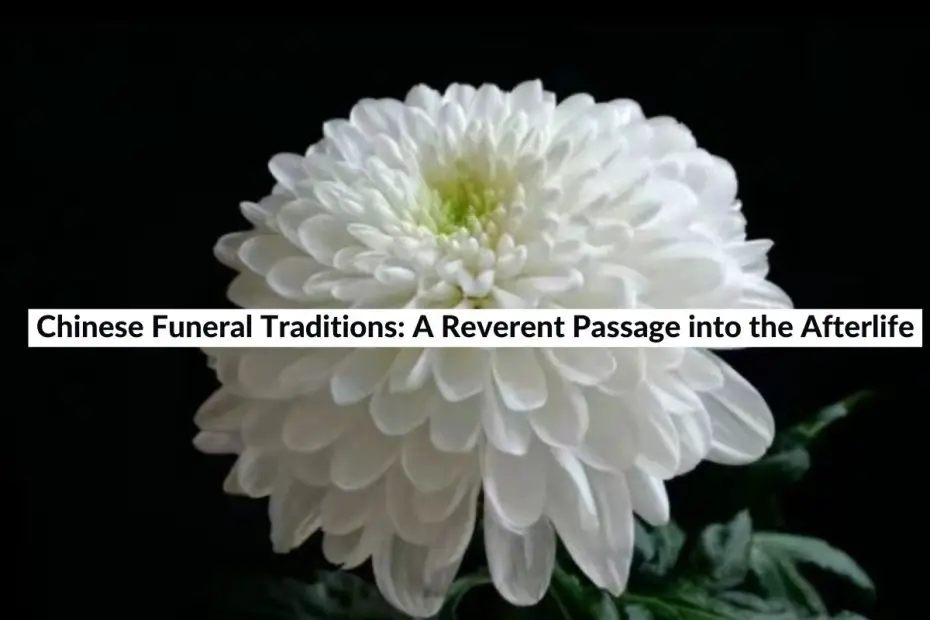Funerals hold great significance in Chinese culture, reflecting the respect and reverence for the deceased and the belief in the afterlife.
Chinese burial customs and funeral traditions are deeply rooted in ancient practices, regional customs, and cultural beliefs.
Understanding these rituals and taboos is essential to show proper respect and support during a Chinese funeral.
In this article, we will explore various aspects of Chinese funeral customs, burial traditions, mourning rituals, and the do’s and don’ts that accompany these events.
Chinese Funeral Traditions Rituals
Traditionally, Chinese families have been known to host elaborate funeral ceremonies that reflect their societal status.
The family takes on a central role in organizing the funeral, often seeking the assistance of a monk, priest, or clergy member representing their religious traditions.
Mourning Period:
The traditional mourning period in Chinese culture is one year, with the first-born son observing a mourning period of up to three years. However, modern Chinese families typically observe a mourning period of 49 days. During this time, the family engages in weekly prayers for the deceased.
Preparation Before the Funeral:
Upon the death of a loved one, Chinese families make various arrangements. One of the initial steps is consulting a feng shui master to select an auspicious day and time for the funeral and burial.
If a gravesite hasn’t been chosen, the feng shui master assists in selecting a cemetery location that considers factors such as orientation and location, often favoring hillside placements and avoiding areas under trees. (These days most Chinese parents bought their gravesite before the death.)
Chinese families often hold three days of visitation before the funeral. The deceased is dressed in their finest clothing or a traditional white burial robe. Only individuals who lived to be 80 or older may be dressed in red or other colorful clothing.
If feasible, the family may choose to stay overnight with their loved one, even preparing meals on-site. This practice is known as “shǒuyè” or “staying overnight.”
The Day of the Funeral:
At the conclusion of the visitation period, the casket is sealed. Family members present at this moment turn their backs, as it is believed that those who witness the casket closing may have their souls trapped within. Similarly, at the gravesite, family and friends also turn their backs as the casket is lowered into the grave.
During the funeral ceremony, the casket remains open as a sign of respect to the elders and the deceased.
Chinese Funeral Flowers: White or yellow chrysanthemums, symbolizing grief, are commonly used at Chinese funerals. In certain regions, families may opt for white irises.
However, if the deceased was 80 years or older, red flowers may be chosen, and the casket interior may be red as well. Floral arrangements such as wreaths and sprays (huāquān) are often abundant, sometimes filling the entire room.
Female family members may wear mourning flowers in their hair, with the color depending on their relationship to the deceased:
- White: Wife, daughter, daughter-in-law
- Green: Grandchildren
- Blue: Great-grandchildren
- Red: Great-great-grandchildren
Burning Incense and Joss Paper: Throughout the funeral service, incense (xiāng) is burned as a sign of respect and remembrance. Joss paper (xiāng zhǐ), also known as ghost or spirit money, may also be burned. These offerings, often in the form of paper houses, cars, and other items, are intended to provide comfort and necessities for the deceased in the afterlife.
Gifts of Money to the Family: It is customary for funeral guests to give money (diàn yí) to the grieving family. This is typically done at the funeral or one day prior.
The gift is presented in a white envelope and is often an odd dollar amount, starting at $101. The envelope may be handed directly to a family member or placed in a donation box.
Guests can choose to write their names on the envelope or leave it blank.
After the Funeral Service:
Following the funeral, a procession proceeds to the gravesite or crematory. The oldest son or grandson leads the procession, carrying a large portrait of the deceased and an incense holder, followed by other family members. Friends and guests walk behind the family.
Once the casket has been lowered into the ground or taken into the crematory, the service concludes.
Attire for a Chinese Funeral: Traditionally, both family members and guests of a Chinese funeral wear plain white or brown burlap clothes (pī má dàixiào) as a sign of mourning. A son or son-in-law may wear a black armband.
However, due to Western influences, black attire has become more acceptable at Chinese funerals. Guests may choose to wear conservative black dress clothes.
An exception to this tradition occurs when the deceased lived to be 80 years or older. In such cases, the funeral is considered a celebration of a long life, and guests may wear pink or red attire to express their happiness.
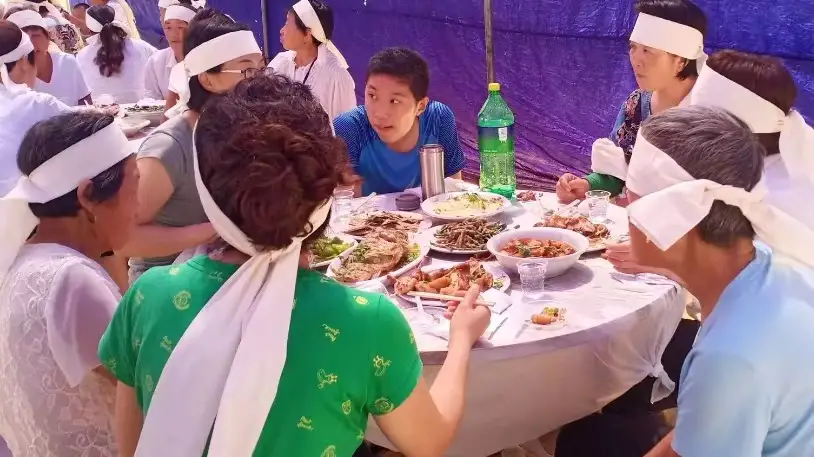
Funeral Feasts: After the funeral, it is common for families to hold a funeral feast or banquet. This gathering allows family members, relatives, and friends to come together to share a meal and pay their respects to the deceased. The funeral feast serves as a way to honor the departed and provide support to the grieving family.
Please note that these customs can vary based on regional practices, cultural traditions, and individual family preferences. Respecting these customs and being sensitive to the grieving family is essential when attending or participating in Chinese funeral rituals.
Cantonese Funeral Customs
Cantonese funeral customs, specific to the Cantonese-speaking regions of southern China and Hong Kong, have their own unique practices and traditions.
Here are some key aspects of Cantonese funeral customs:
Ancestor Worship in Cantonese Culture: Ancestor worship is a central element of Cantonese culture. This involves holding elaborate funeral ceremonies to honor and show respect to deceased ancestors. The underlying belief is that through appropriate rituals, the well-being and protection of ancestral spirits are maintained.
Cantonese Funeral Rituals: These ceremonies typically include the chanting of Buddhist or Taoist scriptures by monks or priests and the execution of specific ceremonial rituals. Key components of these rituals are the lighting of incense, offering prayers, and presenting offerings to the deceased. Participation in these rituals by family members and mourners is a gesture of respect and homage to their ancestors.
Customs for Funeral Attendees: In Cantonese tradition, families often distribute red envelopes containing candy and coins to funeral guests. The red color symbolizes good luck, and the coin represents fortune. This custom aims to replace bad luck associated with the funeral with good luck. Guests are encouraged to consume the candy and spend the coin before reaching home, which is believed to secure their good luck. In contrast, in some other regions, guests may receive a red thread to be tied to their home’s doorknob, serving as a protective charm against evil spirits.
Modern Chinese Funeral Customs
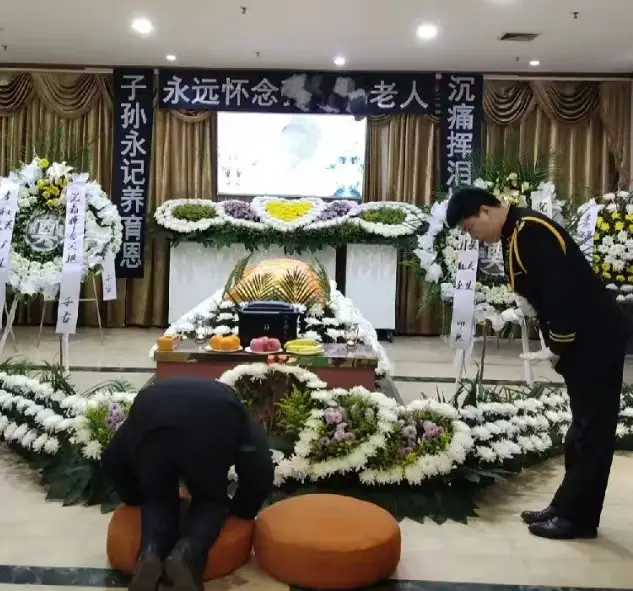
Here’s a table highlighting the changes between traditional Chinese funeral customs and modern Chinese funeral customs:
| Traditional Chinese Funeral Customs | Modern Chinese Funeral Customs |
|---|---|
| Elaborate funeral ceremonies with lavish arrangements | Streamlined funeral arrangements with the assistance of professional services |
| Lengthy mourning period of one year or more | Shorter mourning period of around 49 days |
| Emphasis on ancestor worship and rituals | Incorporation of personalized elements to reflect the individuality of the deceased |
| Burial in traditional gravesites | Increasing prevalence of cremation |
| Limited involvement of funeral service providers | Utilization of professional funeral services for logistics and arrangements |
| Limited use of memorial services | Increasing popularity of memorial services for commemoration and remembrance |
| Emphasis on specific mourning attire, such as plain white or brown burlap clothes | Adoption of Western influences, allowing for more varied attire, including black clothing |
| Reliance on religious figures, such as monks or priests, for guidance and rituals | Continued involvement of religious figures based on family’s religious traditions |
| Focus on traditional rituals and practices | Adaptation to modern sensibilities and preferences, incorporating personalized and meaningful elements |
| Limited use of condolence money | Common practice of offering monetary condolences to the grieving family |
| Limited involvement of funeral attendees in funeral preparations | Increasing reliance on professional services for logistics and arrangements |
The table highlights the changes between traditional and modern Chinese funeral customs. Traditional customs involved elaborate ceremonies, lengthy mourning periods, emphasis on ancestor worship, and specific attire.
Modern customs have streamlined arrangements, shortened mourning periods, personalized elements, increased cremation, and incorporation of Western influences. These changes accommodate contemporary lifestyles while honoring the deceased and supporting grieving families.
Regional and individual variations exist.
Chinese Funeral Taboos: Do’s and Don’ts After Chinese Funeral
Do’s:
- Make regular offerings before the spiritual tablet within 49 days of their passing.
- Utilize the time within 49 days for self-reflection and emotional settling.
- Wear red after “combination prayers” on the 1st-year death anniversary to mark the end of the mourning period.
Don’ts:
- Avoid entertainment during the wake period.
- Avoid visiting friends or relatives within 49 days of their passing.
- Don’t wear bright-colored clothing or attend weddings, celebratory events, or funeral wakes of friends or acquaintances within 100 days of their passing.
- Postpone any events other than Chinese customary weddings until a year later. (Learn Chinese wedding traditions and makeup look here.)
- Refrain from conducting celebrations at home, including Chinese New Year and Chinese festival celebrations, before the 1st-year anniversary.
- Avoid visiting relatives’ houses during the Chinese New Year period.
What to Say at Chinese Funeral
- 深表哀悼 (Shēn biǎo āidào) – Deeply mourn
- English translation: “I deeply mourn.”
- 衷心慰问 (Zhōngxīn wèiwèn) – Sincere condolences
- English translation: “Sincere condolences.”
- 祝逝者安息 (Zhù shìzhě ānxī) – May the departed rest in peace
- English translation: “May the departed rest in peace.”
- 此时此刻,我们心怀悲痛 (Cǐshí cǐkè, wǒmen xīnhuái bēitòng) – At this moment, we mourn with sorrow.
- English translation: “At this moment, we mourn with sorrow.”
- 愿逝者在天堂得到永恒安宁 (Yuàn shìzhě zài tiāntáng dédào yǒnghéng ānníng) – May the departed find eternal peace in heaven.
- English translation: “May the departed find eternal peace in heaven.”
- 请节哀顺变 (Qǐng jiē’āi shùnbiàn) – Please accept my condolences and may you adapt to the changes.
- English translation: “Please accept my condolences and may you adapt to the changes.”
- 希望你们能够坚强度过这段难过的时光 (Xīwàng nǐmen nénggòu jiānqiáng dùguò zhè duàn nánguò de shíguāng) – I hope you can stay strong during this difficult time.
- English translation: “I hope you can stay strong during this difficult time.”
49 Days After Death Chinese Tradition
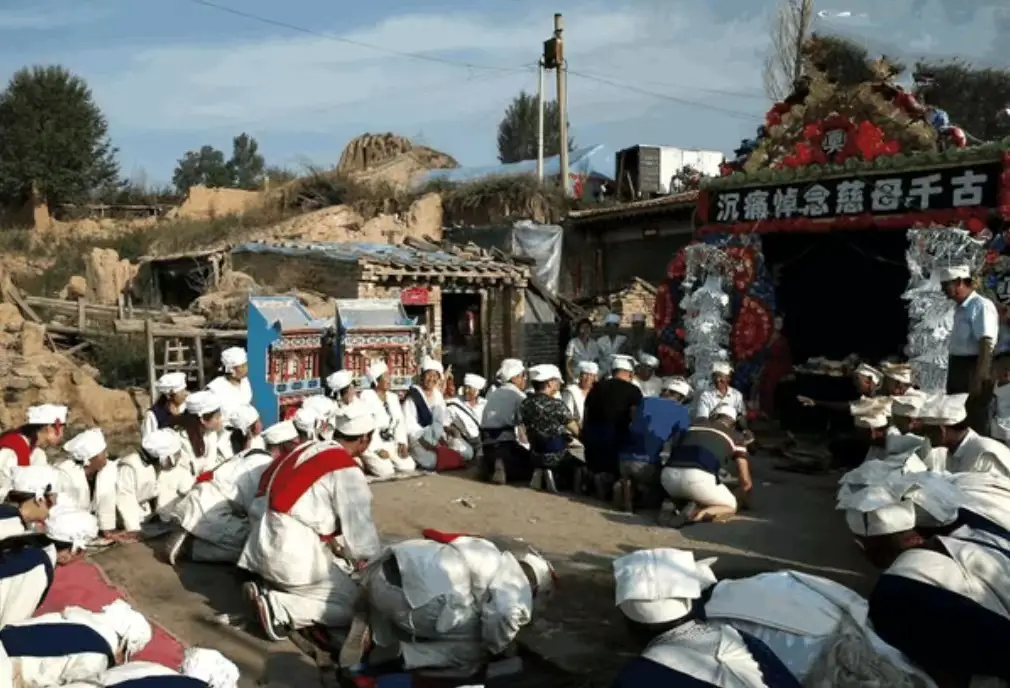
The tradition of observing the 49 days after death in Buddhism holds significant importance and involves various rituals and ceremonies. It originates from “The Tibetan Book of the Dead,” also known as the “Bardo Thodol,” which guides the consciousness of Tibetan Buddhists towards rebirth after death.
According to Buddhist beliefs, individuals go through stages after death before their next incarnation, and the 49-day period is considered the longest duration for the intermediate state. The daily religious ceremonies during these 49 days aim to offer prayers and improve the chances of a positive rebirth for the deceased.
It is believed that the consciousness of the deceased may encounter apparitions during this stage, and prayers help guide them through the process. The 49-day tradition not only facilitates the journey of the departed soul but also provides a timeframe for loved ones to mourn and cope with the loss.
Beyond the 49 days, additional ceremonies may be held at specific intervals during the year following the person’s death, further aiding in the mourning process. It is important to note that the 49-day tradition is particularly associated with Tibetan Buddhism and is practiced in areas influenced by Tibetan Buddhist beliefs, including Tibet, Vietnam, Nepal, and Central Asia.
Chinese Funeral Superstitions
- Name Writing in Red: Writing a person’s name in red ink is seen as a curse due to its historical association with executed individuals.
- Actions Associated with Death: Sticking chopsticks upright in a rice bowl, resembling incense sticks, is considered insensitive and disrespectful.
- Additional Superstitions:
- Avoid clipping fingernails or toenails at night to prevent visits from the dead.
- Continuous dog howling is believed to predict an imminent death.
- Dreams of snow or teeth are considered signs of a parent’s death.
- Chinese families may leave water infused with pomegranate before attending a funeral to protect against evil spirits.
- Engaged couples and pregnant women are advised not to attend funerals to avoid inviting misfortune.
- If a close loved one passes away, it is customary to postpone the wedding for one to three years.
- Red strings may be given at funerals to tie around one’s finger for protection against malevolent spirits.
Chinese Condolence Gifts
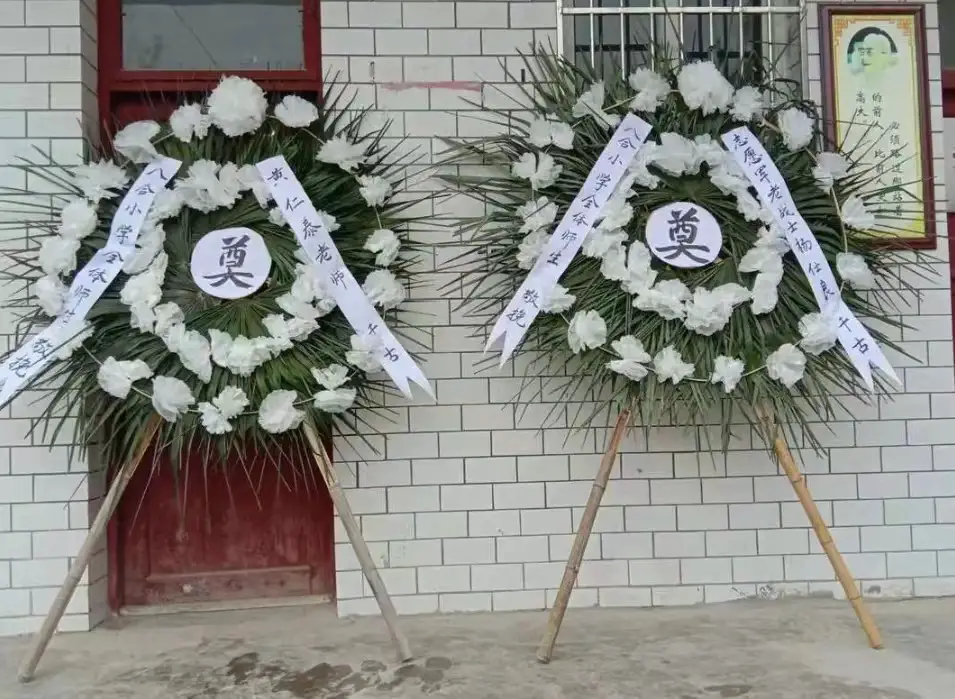
- Funeral Flowers:
- Ideal Choices: White chrysanthemums, lotus flowers, orchids.
- Contextual Note: Use yellow or white chrysanthemums only for funerals to avoid unintended associations with death.
- Fruit Baskets:
- Composition: Include a variety of fruits like apples, oranges, and pears.
- Cultural Tip: Avoid pairing pears, as it’s considered inauspicious.
- Monetary Gifts:
- Presentation: Offer money in a red envelope or condolence card.
- Amount: Choose an odd number (e.g., 101, 501) to steer clear of even numbers linked to happiness.
- Food and Snacks:
- Suggested Offerings: Traditional Chinese foods or sweets, such as nian gao (sticky rice cakes) or dumplings.
- Purpose: These provide comfort to the bereaved family.
- Incense or Candle Sets:
- Use: Common in funeral rituals to honor the deceased.
- Gift Idea: Considered a thoughtful condolence gesture.
- Condolence Letters or Scrolls:
- Form: Handwritten, expressing sympathy and support.
- Personal Touch: They convey a meaningful and personalized sentiment.
General Advice for Condolence Gifts:
- Be Mindful of the family’s customs and regional preferences.
- Delivery: Ideally, present in person or via a trusted individual if direct attendance is not possible.
Why Chinese Add 3 Years After Death?
The mourning period typically lasts for three years, although in reality, it is often observed for approximately twenty-five to twenty-seven months.
This duration aligns with the teachings of Confucius, as it symbolizes the time it takes for a human child to be completely weaned.
Throughout the three-year mourning period, family members may engage in activities such as refraining from festive events, and abstaining from certain behaviors as a sign of respect and mourning.
Why Do You Bow 3 Times?
The act of bowing three times at a funeral in Chinese culture has its origins in a formal tribute called “三拜九叩” (3 bowing and 9 kowtow). It was a ceremonial gesture used when requesting an audience with the emperor or paying tribute to deities. The bowing involved kneeling, touching the ground with the head three times, and repeating the sequence three times.
The numbers 3 and 9 held symbolic significance, representing nobility and the trinity concept of heaven, earth, and humans. Nowadays, this specific form of tribute is limited to formal temple ceremonies, while everyday bowing in Chinese culture is a simpler gesture of bending forward while standing upright.
Why Do Chinese Wear White at Funerals?
- The use of white in Chinese mourning attire dates back to the Zhou Dynasty. Our ancestors, being weak and unable to fend off fierce animals, were highly exposed during daylight, which instilled an innate fear of the color white. As a result, white became a taboo color in Chinese culture.
- The earliest clothing materials in China were made from hemp, which, after the processes of retting and bleaching, would turn white. Thus, during funerals, people would wear white clothing made from hemp fabric.
